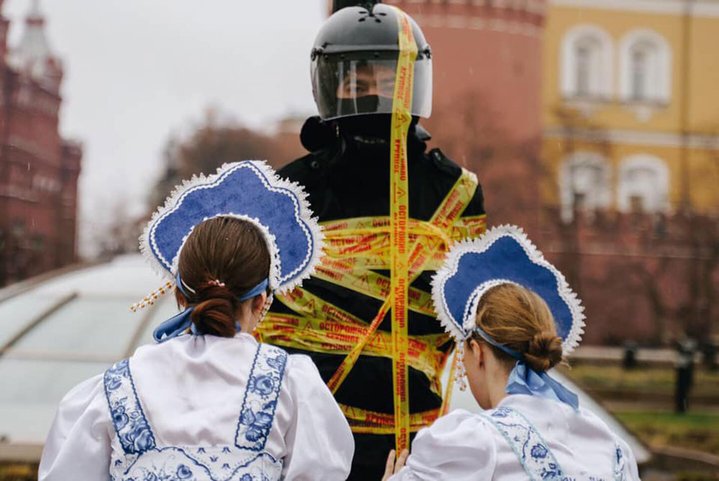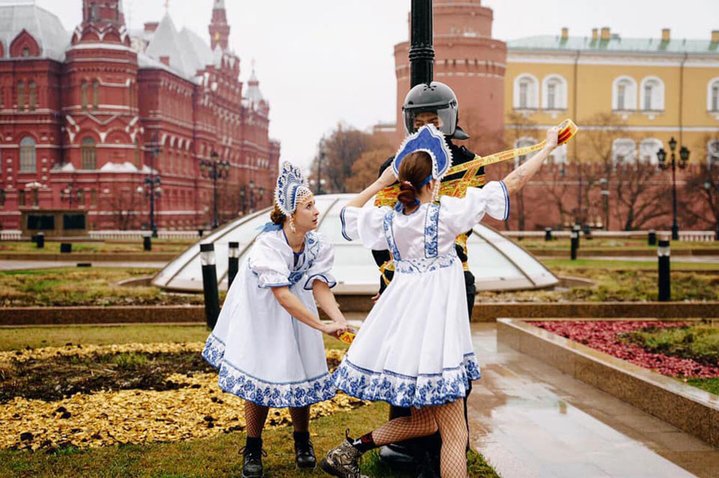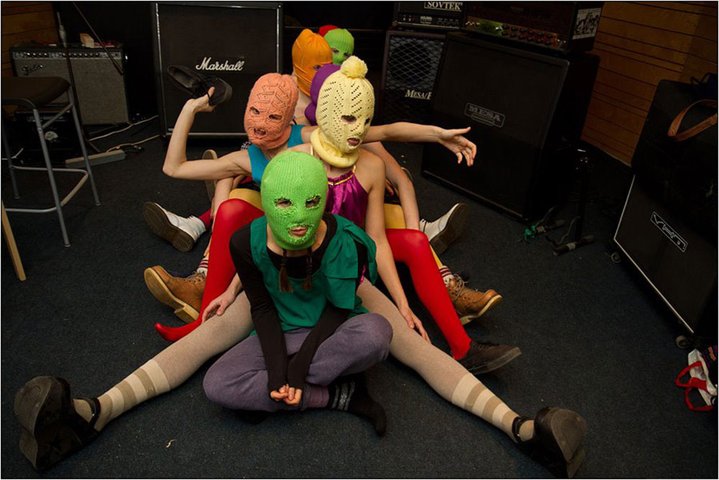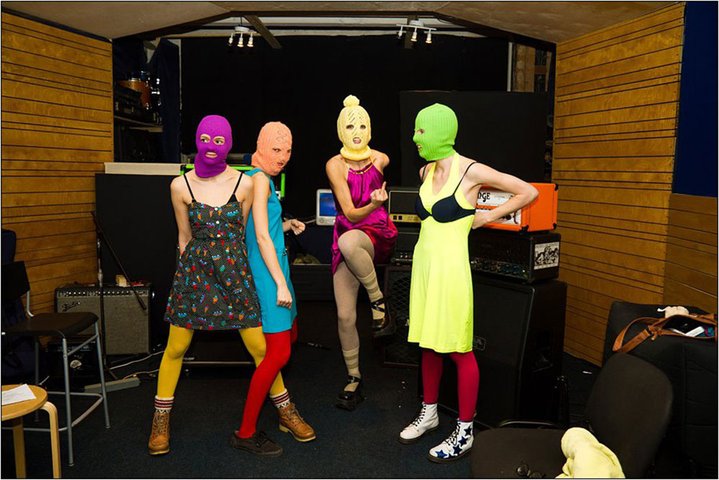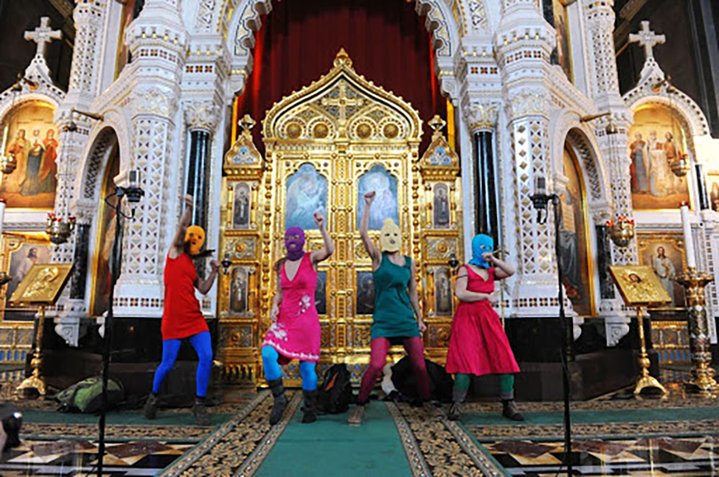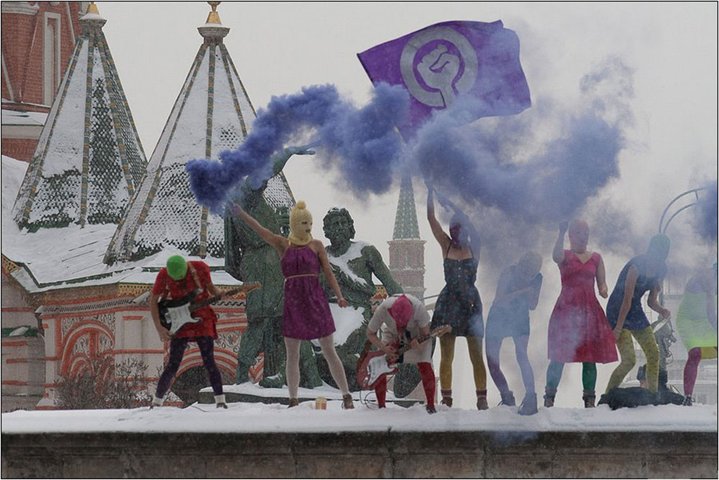Pussy Riot. Putin Zassal (Putin has Pissed Himself). Action on Red Square, 2012.
Pussy Riot: still on the edge
The Russian activist art group with a fluid line-up and unyielding spirit is in action again. Its members Maria Alekhina and Farhad Israfilli-Gelman discuss their motivations, how to find inspiration and their most recent action near Red Square.
Two young women dash into the camera frame. They are wearing black combat boots and white dresses embellished with blue lace. Bedecking their heads are shimmering kokoshniki, a Russian folk headpiece once worn by women to signal their married status and now a staple at any souvenir stand. The pair jogs in circles around a person dressed in police riot gear and whose hands have been bound to a lamp post. Around they go, wrapping the person’s arms, torso, and helmet in yellow packing tape marked with the phrase: “Ostorozhno, Khrupkoe!” (“Careful, Fragile!”). These words are also the title of the most recent action by the art collective Pussy Riot, which took place last November 28 at the edge of Moscow’s Red Square. In total, it lasted only 60 seconds — though as a social media post, of course, its lifetime has extended immeasurably. The participants were Maria Alekhina (b. 1988), one of Pussy Riot’s founders, as well as Rita Flores and Farhad Israfilli-Gelman. While all three were eventually arrested, it was only Flores who was sentenced to 20 days of administrative arrest for “repeated violation of the rules on public gatherings”. Alekhina was fined 15,000 rubles (approx. 200 USD).
“We protested against torture, violence and brutal aggression on the part of the police system,” Alekhina told me in a phone conversation two weeks after the action. “It is claimed that the police exist to protect our rights, when in fact they are doing just the contrary. They oppress.” By immobilising a police officer through performance art, the trio’s action reverses the roles by pointing to the ultimate impotence of a sovereign state and the forces it uses to maintain power.
Since Pussy Riot’s 2012 ‘Punk Prayer’ in Moscow’s Cathedral of Christ the Saviour, the subsequent trial and their imprisonment for “hooliganism motivated by religious hatred” made them world famous, the collective has continued to inspire both admiration and hatred. Pussy Riot’s more recent actions, in which men now also participate, include hanging Rainbow Pride flags on Russian state institutions on October 7 to mark President Putin’s birthday, as well as running onto the pitch of the World Cup football final in 2018, dressed as police officers, in order to draw attention to human rights abuses. Several Pussy Riot’s members, who came of age during an era of political upheaval, also draw their radical streak from the anarchic art collective ‘Voina’ (‘War’). Voina’s best known stunt was creating a giant penis painted on a St. Petersburg drawbridge right next to the local headquarters of the FSB, the successor of the KGB. It took place in June 2010, during a major economic forum attended by Vladimir Putin (who was at the time serving a four-year stint as prime minister) in that city. The illuminated penis shone far away in the night on the erected bridge. The FSB ordered it to be lowered, but the river authorities refused to comply because, as every night, many ships were waiting to sail. Maria Alekhina, as well as another of Pussy Riot’s founders, Nadya Tolokonnikova (b. 1989) and her ex-husband Pyotr Verzilov (b. 1987), were all Voina members. Both Israfilli-Gelman and Alekhina skirted the question of how many adherents Pussy Riot now has. The first simply said “there are many Pussy Riot members I don’t know”, while Alekhina replied that “anyone can be Pussy Riot”. “We aren’t a political party. We don’t have membership cards. Everyone who does a political action, who wears a balaclava or supports us with their solidarity, is a member,” she said.
Despite their emphasis on collective action, Alekhina’s charisma clearly drives the work Pussy Riot does in Russia today. In conversation, her voice is strong, punctuated by thoughtful pauses and the occasional impatience. “She is an engine, a magnet, drawing people to her,” is how Israfilli-Gelman puts it. When we spoke, Alekhina had just arrived in a city, some 1,000 kilometers from Moscow. Within three hours of getting there, the windows of her car were smashed. Asked how she nevertheless retains her energy, she replied, “if it doesn’t kill us, it makes us stronger.”
In his essay ‘Critique of Violence’, the philosopher Walter Benjamin (1892--1940) wrote that even “great” criminals will enlist the sympathy of the public, not because the public approves of their deeds, but because their bodies bear witness to the violence of the law. For Pussy Riot, the process has entailed confronting the ideas and people they’re fighting against, often taking it to an extreme. Tellingly, during their 2012 trial, several public figures from across the Russian political spectrum called for the group’s corporal punishment. Later, the group was whipped by Cossacks during the 2014 Winter Olympics while performing an action in the city of Sochi.
In part, this bodily violence continues to have a sexual component. One of the most widely circulated images of the group’s trial was of the young women in handcuffs, faces peering out from behind bars. At the time, the Bulgarian artist Boryana Rossa (b. 1972) sarcastically called it “the wonderful aesthetics of beauties behind bars”. Alekhina told me about a conversation she had with a taxi driver. “I told him about the ‘Careful, Fragile’ performance and our work and so on. He said, ‘Oh, it was you guys who were naked in the church.’ I said, ‘We weren’t naked. We sang a song about ousting Putin.’”
One of the thorniest questions about protest art has to do with impact. And how can impact be measured? Although Pussy Riot’s global press coverage, particularly in the Europe and the USA, has overwhelmingly praised them as martyrs of state violence, their reception in Russia — even among supporters — can be considered ambivalent at best.
However, this does not seem to trouble Alekhina. “The point of the action is to do it. In that sense, the ‘Careful, Fragile’ action was successful,” she said. Yet, this seems to contradict the group’s larger project of changing minds and drawing attention to events that are warping Russian society. The topic of violence against women enlivened her. “We live in a country where domestic violence is no longer a criminal offence, where women are blamed for the violence enacted upon them... in this sense, how can feminism not be a part of our practice?” Alekhina sees her own work abroad as exploring other forms of protest art. “Our audience is everyone who encounters our work, intentionally, by chance, or in the future,” she said. “You can’t live nowhere, you can’t live in a vacuum. One way or another, you are always reacting to an event that is happening around you.”
It remains to be seen what impact Pussy Riot will ultimately make. Will it tighten the screws in Russia? After all, the Russian law against blasphemy was drafted after the group’s 2012 trial. Or will it expose the state’s weakness thanks to the group’s future work? For now, according to Alekhina, she will continue to draw inspiration from previous activists. “People who dedicated their lives to changing these norms, they are really true heroes. In difficult moments, I always think of them,” she said.






